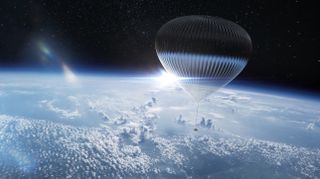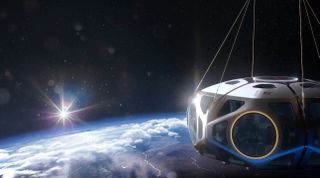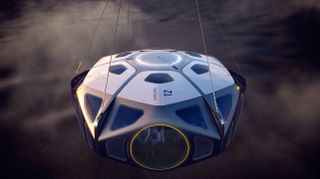
Aspiring space tourists now have another option to consider.
World View Enterprises is developing a balloon-based system that will carry people to the stratosphere, with the first commercial flights targeted for early 2024, the Arizona-based company announced today (Oct. 4).
The typical ride will last six to eight hours and take passengers to an altitude of at least 100,000 feet (30,000 meters), where they'll be able to see the curvature of Earth against the blackness of space. But the overall experience will last five days, which will be spent in and around sites of natural beauty and cultural and historical significance, World View representatives said.
Related: World View wants to open a new market in the stratosphere

"World View's ambition is to change the conversation around space tourism. It's not just a joyride; it's so much bigger and more important than that," company president and CEO Ryan Hartman said in a statement. "We're redefining space tourism for participants by spending hours at apogee [a flight's highest point], building memories around some of Earth's most magnificent wonders."
Each seat on the company's pressurized, eight-passenger Explorer capsule sells for $50,000 — significantly less than any other major space-tourism outfit is charging. And the ride to the stratosphere will be smooth and gentle enough to accommodate people of widely varying ages and fitness levels, according to World View representatives.
"By designing a space tourism experience that is more affordable and more accessible to more people, we're hoping to give as many humans as possible the chance to see our planet from unprecedented new heights," Hartman said.
Get the Space.com Newsletter
Breaking space news, the latest updates on rocket launches, skywatching events and more!
And World View already has a customer for its first crewed, commercial flight. The nonprofit Space For Humanity bought all of that debut mission's seats and will fill them with citizen astronauts that it will select and train.
"We are very excited about securing World View's first commercial capsule," Rachel Lyons, executive director of Space for Humanity, said in the same statement.
"Our mission is to expand access to space to all and in doing so, support the transformation of our world’s most ambitious leaders so they can use their experience in space to create positive change here on Earth," Lyons added. "This is a groundbreaking time for space tourism, and we're looking forward to giving more people the opportunity to experience it for themselves."

World View space tourism, take two
This isn't World View's first foray into space tourism. Nearly a decade ago, the company announced plans for a balloon-capsule system called Voyager, which would ferry folks to the stratosphere for $75,000 per seat.
At the time, World View said it hoped to get Voyager up and running by 2016. That didn't happen. And in 2019, two of World View's co-founders, Taber MacCallum and Jane Poynter, started a new company called Space Perspective, which is now developing a balloon-capsule system of its own called Spaceship Neptune. Florida-based Space Perspective hopes to begin commercial tourist flights to the stratosphere in 2024, and it's selling tickets on the vehicle for $125,000 apiece.
The Explorer plan shares some similarities with Voyager's design — for example, ascending with the aid of a giant balloon but landing beneath a parasail on dry ground. (Spaceship Neptune, by contrast, won't employ a parasail, and it will return to Earth via ocean splashdowns.) But Explorer is not just Voyager rebranded, Hartman said.
"The entire thing is different," he told Space.com in an interview.
The new concept centers on a desire to help foster "an inspired perspective for a radically improved future," Hartman added. That desire led the company to map out immersive, five-day customer experiences in launch sites that are tourist draws in their own right.
For example, the first operational Explorer flights are scheduled to lift off from Page, Arizona, close to the Grand Canyon. Customers will have the chance to explore the nearby Navajo and Hopi reservations, among other excursions, before settling in to soar high above Earth's most famous canyon system.
World View plans to lift off from six other sites around the world as well: Queensland, Australia, near the Great Barrier Reef; Kenya; Norway; Amazonian Brazil; Mongolia, near the Great Wall of China; and Egypt, near the Giza Pyramid Complex.
The Explorer flight experience will be luxurious, company representatives said. The capsule will feature reclining seats, high-speed internet access, Earth-facing cameras and star-spotting telescopes, among other amenities. Two World View employees will travel on each flight, with one serving as a concierge and the other an operator and tour guide. Meals and drinks, including specially devised cocktails, will be served. And yes, there will be a bathroom on board.
World View is still developing the Explorer capsule, Hartman said. But the company has already conducted four flights with the giant balloon earmarked for the project, he added. When fully inflated, that balloon holds 17 million cubic feet (481,400 cubic meters) of gas.
The Explorer capsule and parasail will be reusable. The balloons will not, but each one will be recycled post-flight into products that benefit communities near the liftoff site, Harman said.
Photos: The first space tourists

Space tourism taking off
World View is entering an increasingly busy and active field, one that's taking paying customers to a variety of altitudes.
World View and its most direct competitor, Space Perspective, offer rides to the stratosphere. Both Virgin Galactic and Jeff Bezos' Blue Origin are selling trips to suborbital space (to altitudes around 62 miles, or 100 kilometers) aboard rocket-powered craft, which require deeper pockets. Virgin Galactic's current ticket price is $450,000; Blue Origin hasn't announced what it's charging, but it's expected to be in the same ballpark as Virgin Galactic, if not more expensive.
And SpaceX recently launched four people on the first-ever all-private mission to Earth orbit, a flight called Inspiration4 that employed the company's Crew Dragon capsule. Inspiration4 was booked and commanded by billionaire Jared Isaacman, who has not divulged how much he paid. But it was likely around $200 million, if the per-seat prices that NASA pays for Crew Dragon flights to the International Space Station are any guide.
SpaceX is scheduled to launch another orbital tourism mission in February, a Crew Dragon trip to the space station that will be operated by Houston company Axiom Space. And Japanese billionaire Yusaku Maezawa and a video producer will fly to the orbiting lab aboard a Russian Soyuz spacecraft this December. (A Russian film crew will also launch to the station aboard a Soyuz on Oct. 5, but Russia's federal space agency Roscosmos is apparently footing at least part of that bill.)
So there's a lot going on. But World View is confident it can carve out a place for itself in the space-tourism arena.
"I don't see this as a fight for market share at all," Hartman told Space.com. "In fact, I see it as a broadening of the ecosystem that we're all feeling called to create."
World View already has extensive stratospheric flight experience, with robotic balloon-based craft the company calls Stratollites. Stratollites are designed to carry payloads aloft for long durations, allowing customers to gather a variety of remote-sensing data.
World View will continue operating Stratollites, but the company expects Explorer to eventually become its biggest moneymaker.
"Revenue-wise, space tourism is going to be 65 to 70% of our business," Hartman said. "We're so excited about this business."
Mike Wall is the author of "Out There" (Grand Central Publishing, 2018; illustrated by Karl Tate), a book about the search for alien life. Follow him on Twitter @michaeldwall. Follow us on Twitter @Spacedotcom or Facebook.
Join our Space Forums to keep talking space on the latest missions, night sky and more! And if you have a news tip, correction or comment, let us know at: community@space.com.

Michael Wall is a Senior Space Writer with Space.com and joined the team in 2010. He primarily covers exoplanets, spaceflight and military space, but has been known to dabble in the space art beat. His book about the search for alien life, "Out There," was published on Nov. 13, 2018. Before becoming a science writer, Michael worked as a herpetologist and wildlife biologist. He has a Ph.D. in evolutionary biology from the University of Sydney, Australia, a bachelor's degree from the University of Arizona, and a graduate certificate in science writing from the University of California, Santa Cruz. To find out what his latest project is, you can follow Michael on Twitter.